The Day Lasts More Than a Year *
Li Xiaoshan
A few years ago, Zhu Wei and I had an in-depth conversation about the phenomena of ink painting and the things behind them. We came to different conclusions, not surprisingly, for we saw it from different perspectives. A while ago, Zhu Wei brought up this matter again, which made me think a lot and dive deeper. The "fever" of ink painting has been going on for a long time, and to all appearances, it has become an unyielding trend. Almost everyone, from artists to critics, from art market to someone outside the circle, are entrapped in it, they enjoying its favor, promoting its bright future, or, following the crowd bewilderedly. In a word, the field of ink painting seems to flourish as spring were here. However, I must emphasize that the blooming flowers in this field are just an illusion, most of which, in fact, are dazzling but lifeless plastic flowers.
In an article I wrote twenty years ago, titled “From Chinese Painting to Ink Painting”, I talked about the strategy and logic behind the naming of this art form. Indeed, Chinese painting and ink painting are like two coats of different styles, applying to the same person by different requests at different times. For ease of understanding, here I will state my conclusion first: after more than three decades, all the way from anxiety, tentativeness to stability, the field of ink painting has gradually become an obvious closed loop - compared with the traditional art, it is contemporary, and compared to the Western art, it is indigenous. In such a closed loop, everything is self-circulating, self-arguing, and self-positioning. Tom is the standard of Dick, while Dick is the standard of Harry, and so on. The vertical axis of historical context has disappeared; the horizonal axis of lateral comparison is gone. Everything is its own destiny, and therefore only necessity exists. Where are probabilities and possibilities? Where are inheritance and creation? Where are the artists and works that can be associated with art history? When we talk about ink painting, these unquestionable questions once again become a Hamlet’s query.
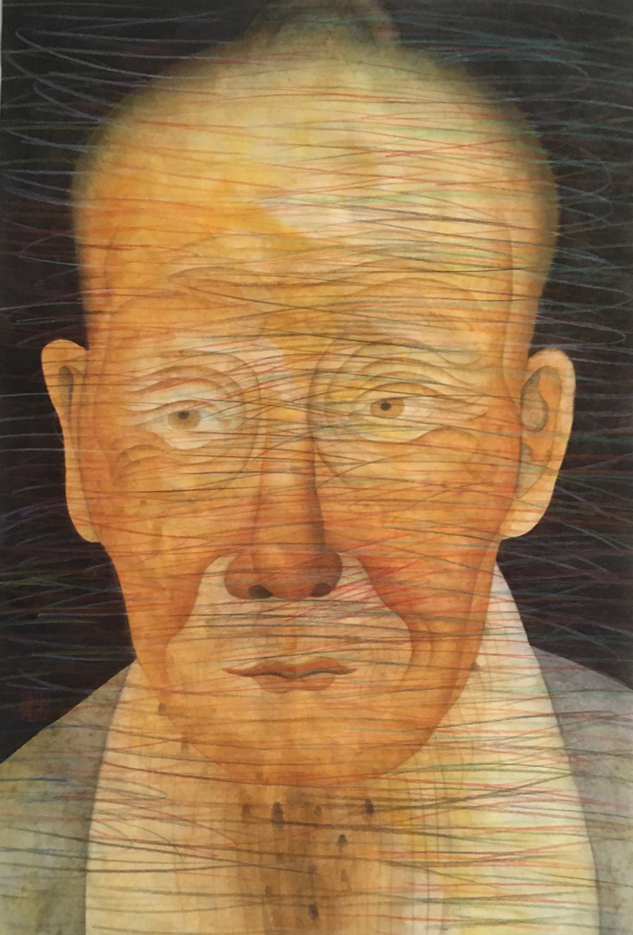
Zhu Wei "Huang Gongwang", ink and color on paper, 39 x 59 cm 朱伟《黄公望》 2020 水墨设色纸本 39 × 59 厘米
Everyone knows the metaphor of the elephant in the room. Whether ignoring it deliberately, or accepting it blindly, there is no fundamental difference. As an art form born and brought up in China, ink painting has been questioned and criticized constantly since the beginning of the last century. Many artists and theorists cudgeled their brains on it, producing all kinds of theories, and based on which, contributing some seemingly valuable and exploratory works. Later, with the reform and opening up, another cycle of samsara has emerged in ink painting, with the basic features of the last cycle, but a larger quantity. The scale is evident, which is reflected on, to name a few, numerous large or small ink painting exhibitions, endless so-called academic seminars, countless self-proclaimed market darlings, and various booming associations, schools, and painting academies. These mirages lead to delusions, and delusions can make people exciting and arrogant, even they will not last. In my experience, many clever people in the ink painting circle have sensed the emptiness behind the self-entertainment and self-exaltation. Nevertheless, being lack of confidence or strength, they would rather live in the mirages.
Coming back to the topic of Zhu Wei - the label on him is ink painter. There is something magical about labels, which can subtly shape people's thoughts and behaviors. However, some people are peculiar, who can lie down with dogs but get up without fleas. Here I would rather not use the lofty words “come out of the dirty mud unsoiled”, for, in this field, Zhu Wei is not a supporter of loftiness. He has always been moderate, modest, keeping a low profile, and of a little bit of perfectionist; he put more efforts in painting rather than words. These are virtues, and they come from his long-standing sense of propriety. I remember once he told me that the key to evaluate something or someone is time. “Three years to five years, eight years to ten years, or fifty years to a hundred years, when the time span is different, the standard is completely different. If the standard is lowered by one inch, there will be a bunch of masters, and if the standard is lowered by one meter, masters will be all over the world.” I couldn't help laughing, “for you, a day lasts more than a year.” Zhu Wei waved without answering. I always have a feeling that there are two different Zhu Weis coexisting inside him – one is an ink painter, and the other is an artist; one is entirely contemporary, and the other has an obsession for classics. The two Zhu Weis sometimes coexist peacefully, and sometimes conflict. I often felt regret that among so many our artists, writers, directors, and musicians, nobody could see the inner conflict, as well as the ultimate realm stimulated by inner conflict. They live as if life is peaceful, which led to the hollowness and flatness of their works. There is no doubt that the passion and motivation of art creation comes mostly from the inner world of an individual, and it is also where the secret of creation lies in.
As I previously mentioned, the field of ink painting is gradually becoming a closed loop, and here it doesn't matter whether it is a fact or an opinion, for in front of creation, all facts and all opinions are hypotheses. It is said that everyone is a product of the environment. I would say that only trees, flowers and plants are the products of the environment, but not human beings, at least not all of them. As for artists, they have the privilege of surpassing the environment: artists have always been flying in parallel with the environment, far more than just a shadow of it. Throughout the history, there were a lot of examples. Even now, the closed loop in the making is still not so closed. As the well-known saying goes, “there is a crack in everything, that's how the light gets in."** The status quo of ink painting is undoubtedly disappointing, but not hopeless. After all, my opinion was yet an entry-level insight into art. For instance, when Zhu Wei and I discussed about "New Literati Painting", "New Ink Painting", "New Freehand Brushwork", " New Gongbi" and other new trends, in his usual cold and humorous way he said, “there is no easy life. They should be allowed to get some food from their own plots.” Sure, the threshold for art is too low, hence ordinary people dare not pretend to be a scientist or a medical professional, while those who call themselves artists are packed. On the other hand, the standard of art is too high, for becoming an artist, who will not eventually be eliminated by time, is as difficult as a camel passing through the eye of a needle. Zhu Wei has fifty years and one hundred years in his mind, and one step at a time, he put it into practice – and he has outstanding works. So, is he standing in or outside the closed loop?
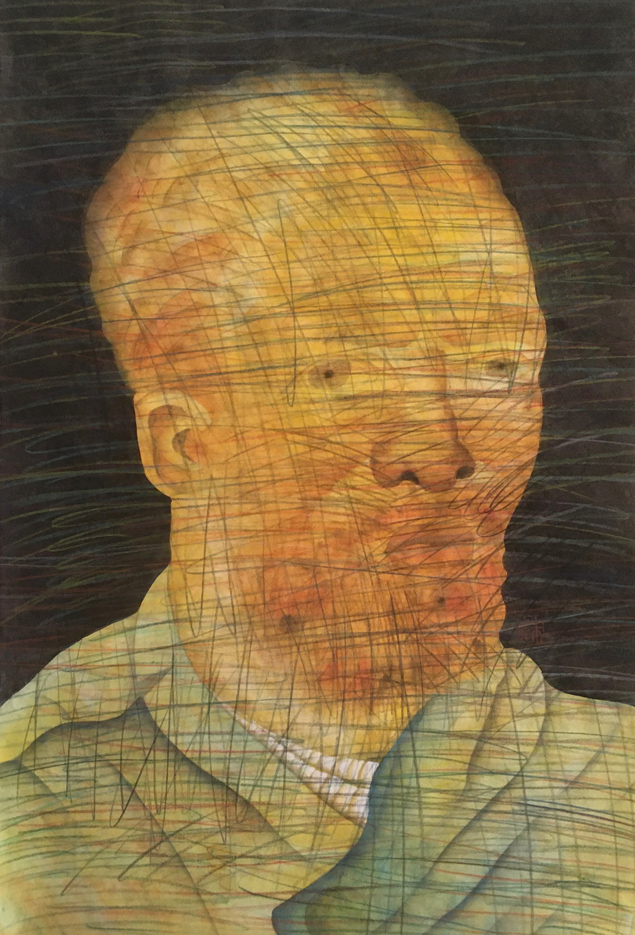
Zhu Wei, "Van Gogh", ink and color on paper, 39 x 59 cm 朱伟《梵高之一》 2020 水墨设色纸本 39 × 59 厘米
We have to look for the evidence in Zhu Wei's artworks. As I can recall, Zhu Wei was the first person who deliberately introduced ink painting to the door of contemporary art. In other words, when most people were still asleep, he woke up early - and, he was not woken by others, but woke up naturally. People who understand contemporary art know that contemporary art emphasizes concepts over means, where concepts is the core, means (including materials and so forth) is in a subordinate position. The materials of ink painting should not be an obstacle to creation. However, within the closed loop mentioned above, people have adopted an approach of collective unconscious: they made a cocoon around themselves as a cave, a place to avoid the vertical and horizontal comparison, so that they could relieve themselves from the anxiety and pressure when facing such confrontations. Zhu Wei woke up early and naturally, unlike the ones who were woken up by others – as soon as they opened their eyes, and realized that a thousand years outside the cave was as a passing night, they hastily changed their coats and jumped on the bandwagon without thinking. The advantage of waking naturally is that every step of creation, from sowing to harvesting, from flower to fruit, happens by nature, and it all comes from the surging talent and impulse inside.
For years Zhu Wei has created a number of his representative works: “The Story of Beijing”, “New Pictures of the Strikingly Bizarre”, “Sweet Life”, “Descended from the Red Flag”, “The Square”, “China Diary”, “Tightrope”, “China China”, “Diary of the Sleepwalker”, “Utopia”, “Curtain Series”, “Spring Festival” and so on. Even as of today, these works are important and have a significance of guiding. Zhu Wei has created a unique artistic style - according to my old theory, a unique artistic style, a high degree of difficulty, and a perfect level of implementation are the three elements that accomplish an outstanding artist. For quite a long time, Zhu Wei's works have been labelled and categorized, and since he uses ink brush and xuan paper and other local materials, it is logical for people to label or classify them. I have always opposed to a confusing claiming that contemporary art, on the whole, represents the "advanced knowledge production", because in the field of contemporary art, there are obviously different levels of artworks. Yes, it is correct that contemporary art is the frontier of art in our era - with waves of artists charging into the battle, art will always live prosperously. Even so, advancement is not absolute, but relative, and it will wither once isolated. That is to say, advancement is changing, and as Baudelaire said, things roll forward, one half being eternal and the other being movable. The eternal will last, and the movable is constantly replaced.
There is a contemporary person, with contemporary appearance and contemporary vibe, whilst he also has an obsession with the classics – is there a split in this combination? Zhu Wei is very different. He likes to make friends with all kinds of people; he used to be keen on rock and roll, sports, and other music; he is a person who doesn’t resist fun. In the meantime, no matter what he is facing, he is sincere, disciplined, and virtuous, like a really old-fashioned person. I have met a lot of people who are scheming and say one thing while doing another; they are clean on the front and dirty on the backs. Our ancients always said that the writing mirrors the writer, and the painting mirrors the painter, which is convicting, for the saying has proved itself in practice. I appreciate Zhu Wei's obsession with classics. It is obvious that the classics itself has become a thing of the past, and cannot be revived. Then, why do some people cherish the classics? The reason lies in its fascination. When I look at those Western or ancient classical works, words being powerless, the only thing I can do is to take my hat off to them. I still vividly remember the moment I stood in front of “Wind in Pines Among a Myriad of Valleys” and “Travelers among Mountains and Streams”, I felt so overwhelmed that my eyes became warm. Needless to say, the charm of classics is eternal, and the classics are an eternal standard for art. I can understand that there is no split in Zhu Wei; it is the exterior and interior in the same person. His respect for the classics is revealed in his works bit and bit - eventually, the so-called classic obsession implicates a kind of self-competition. Just like a mirror as well, the great classics is on one side, and the artist is on the other side.
Some people change, and some stay the same. Some people change because they follow the trend, and some people stay the same because their inner aspirations are more important than any trend. The truth is, one will never catch up with the trends, as a shadow can never fly ahead of a bird. Those who remain unchanged, those who persist, and those who are obsessed, will one day be followed by the crowds. It is such a wonderful world, with unmovable mountains and flowing water. I expect Zhu Wei to be the same as always - of course, whether I expect it or not, he will be. Not long ago, he told me in a solemn tone, “what else would I do, if I didn’t keep right on to the end of the road?” Certainly, in the twinkling of an eye, Zhu Wei has been halfway along the road – by and by, he found that he had left behind the crowds that labelled him, away from the noise, and being alone. Moreover, there is no road ahead of him. Lu Xun once said that actually the earth had no roads to begin with, but when many men pass one way, a road is made. It seems that these words are raising an interesting question here: if an artist is walking his own way alone in a vast land, is this road considered a road?
October 7, 2020
Translator's note:
* The translation here is derived from a novel by Chinghiz Aitmatov, The Day Lasts More Than a Hundred Years, translated by F. J. French, published by Indiana University Press (1 February 1988). ISBN 978-0-253-20482-0.
** Leonard Cohen, Selected Poems, 1956-1968.
Li Xiaoshan is a professor at Nanjing University of the Arts, Director of AMNUA, and Director of Graduate School of Contemporary Art of Nanjing University of the Arts.
一日长于一年
李小山
若干年前,我和朱伟做过一次颇为深入的对谈——关于水墨画的诸多现象及现象后面的东西。由于角度不同,结论自然有所出入。前一阵,朱伟又一次提及此事,令我感慨甚多,一些想法也跟着逐渐清晰起来。水墨画“热”已经持续了很长一个阶段,时至今日,俨然成了势不可挡的潮流。艺术家、批评家、艺术市场、圈内圈外,几乎全被裹挟其中,要么乐不可支享受其恩惠,要么不遗余力鼓吹其光明前景,要么糊里糊涂随大流瞎起哄。一言蔽之,水墨画看似迎来了繁花似锦的春天。但是——我想郑重指出,水墨画的繁花似锦只是假象,里面绝大多数只是炫目而无生命的塑料花朵。
二十年前我写过一篇《从中国画到水墨画》的文章,专门讨论了定名背后的策略和根源。是的,中国画和水墨画,不过是两件款式不一样的衣服。不同时期按不同需要套在同一个人身上。为了叙述方便起见,我还是先亮出我的结论:经过了三四十年时间,从焦虑、试探到稳定,水墨画领域逐渐形成了显而易见的闭环——与传统相比,它是当代的,与西方相比,它是本土的。因而,在这样的闭环里,一切都是自我循环、自我论证、自我定位的。张三对照李四,李四对照王五。历史坐标的纵向参照消失了,前后左右的横断面不见了。一切成了宿命,如此一来,唯有必然性像磐石一般存在。或然性和可能性在哪里?传承和开创在哪里?与艺术史对接的画家和作品又在哪里?这些不是问题的问题又一次变为一个水墨画的哈姆雷特之问。
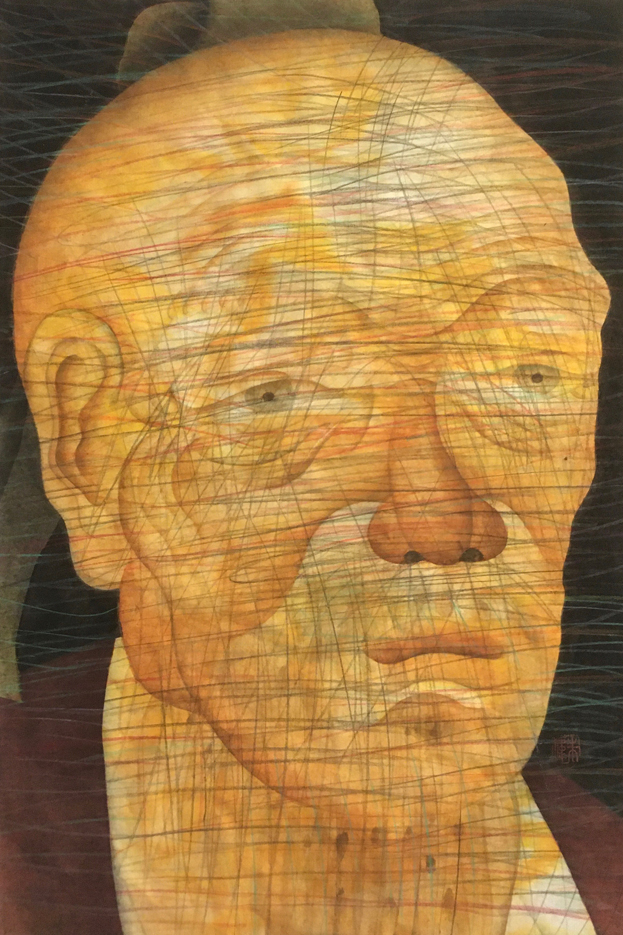
朱伟《傅山》 2020 水墨设色纸本 39 × 59 厘米
大家知道房间里的大象这个隐喻。人们故意忽视它,或者懵然接受它,性质是没有区别的。水墨画作为土生土长的绘画形式,在上个世纪初起便不断遭受质疑和批评。许许多多画家、理论家为此殚精竭虑,制造出各种各样的说辞,贡献出一些有探索有价值的作品。以改革开放为契机,水墨画出现的又一个轮回实际上衔接了以往的基本盘面,只不过在量的扩张上更具规模——请注意,我所说的量的规模,意思十分明确。无数大大小小的水墨画展览,没完没了的所谓学术研讨,许许多多以水墨画家自谓的市场宠儿,各种协会、院校、画院之类机构的蓬勃兴起,不一而足。海市蜃楼的景观确实令人易于产生幻觉——并且,幻觉确实可以使人兴奋和膨胀,但毕竟是持久不了的。在我的经验中,水墨画圈子里的不少聪明人感受到了那种自娱自乐、热烈自嗨的背后的空虚。他们既无信心,又无底气,今朝有酒今朝醉。
回到朱伟——朱伟身上贴着标签:水墨画家。标签这东西有一种魔力,能够潜移默化塑造人的想法和做法。然而,有的人非常奇特,近墨而不黑,近朱而不赤。这里,我不用“出污泥而不染”的崇高字眼,是因为在这方面,朱伟不宣扬崇高,他向来内敛,不事张扬、低调处世,有那么一点精神洁癖,工夫在画上而不在嘴上。这是好的,是他长期以来拿捏准确的分寸感。记得朱伟对我说,看待某个事物,某个人,关键是时间,三年五年?八年十年?五十年一百年?时间不同标准完全不同。标准拉低一寸,大师一箩筐,拉低一米,大师满世界。我不由笑言,对于你,一日长于一年。朱伟挥手而不作答。我总有一种感觉,朱伟内部同时存在着两个不同的朱伟——水墨画家的朱伟,艺术家的朱伟;浑身当代气息的朱伟,心怀古典执念的朱伟。两个朱伟时而和平共处,时而冲突不断。我常常感叹,那么多艺术家、作家、导演、音乐家们,竟然看不到内在冲突,看不到内在冲突造成的极致境界,如此的岁月静好,导致了人是空心的和平面的,作品也是空心的和平面的。毫无疑问,创作的激情和动力更多地来自个人内部,创作的奥秘终究要在个人内部找到真实的答案。
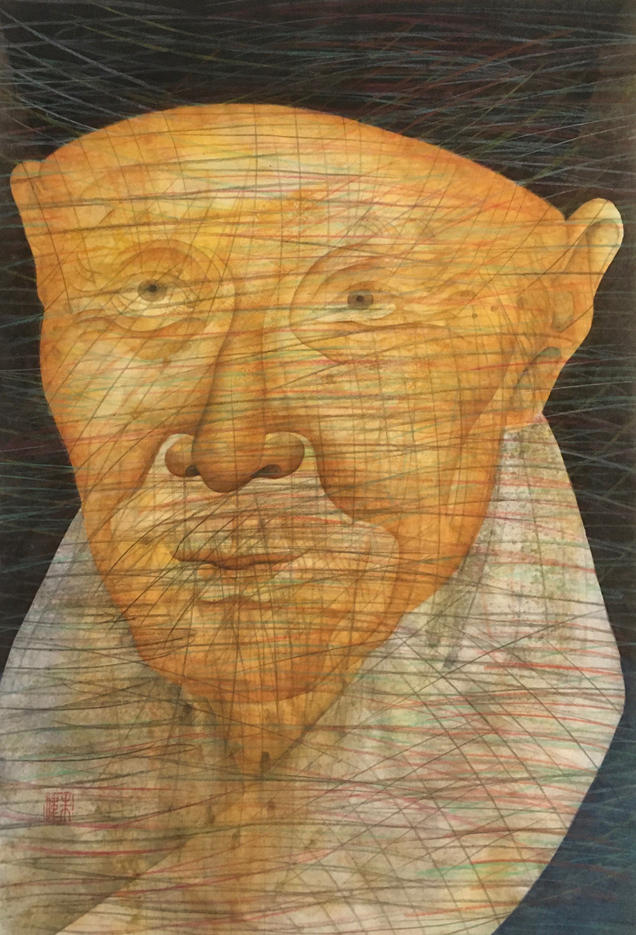
朱伟《沈周》 2020 水墨设色纸本 39 × 59 厘米
如前所说,水墨画领域正在逐渐走向闭环,是事实也罢,是判断也罢,其实并不重要。因为一切事实一切判断在创作面前均是假设。书上说,每个人都是环境的产物,我想说,只有树木花草才是环境的产物,人不是,至少不全是,至于艺术家,则具有凌驾环境的特权:艺术家素来与环境并行而飞,绝非仅是环境的影子——追溯历史,这样的事例数不胜数。即便面对现状,形成中的闭环仍然留下缺口。正如那句大家熟知名言:任何事物都有裂缝,那是光照进来的地方。水墨画的现状无疑让人失望,但并非绝望。究其根本,我相信这仍然是一个对艺术的入门级的见解。譬如,朱伟和我谈到“新文人画”、“新水墨”、“新写意”、“新工笔”这些林林总总的招牌时,以他一贯冷幽默的方式说,都不容易,允许每个人在自留地上讨口饭吃——是的,艺术的门槛太低,普通人不敢妄称自己是科学家、医学家,而自谓艺术家的人却是车载船装。反过来,艺术的标准太高了,艺术家在时间坐标上的淘汰率像骆驼穿过针眼一样的难。朱伟脑子里装着五十年一百年的尺度,付诸实践,一步一个脚印,作品响当当地摆着。那么,他站在闭环的缺口内?还是缺口外?
所以,得从朱伟作品的内部去寻找依据。在我记忆里,朱伟是最早有意识地把水墨画带到当代艺术门口的人。换句话说,当多数人还在睡梦中,他已早早醒来——而且,他不是被叫醒的,是自然醒。了解当代艺术的人都懂得,当代艺术重观念轻手段,观念才是核心,手段(包括材料之类)处在从属地位。水墨材料按理构不成创作的障碍。我所指闭环实质上是人为的作茧自缚、画地为牢,为了逃避纵向和横向对照,采取了一种集体无意识的策略。拒绝了对照,便缓解对照的焦虑,逃避了对照的压力。朱伟醒得早,而且是自然醒——不像很多被叫醒的人,眼睛一睁,发觉洞中才数月世上已千年,于是急急忙忙改头换面,跟风随大流去了。自然醒的好处是,从耕种到收获,从开花到结果,都拜自然而赐,都出自内里奔涌的才情和冲动。
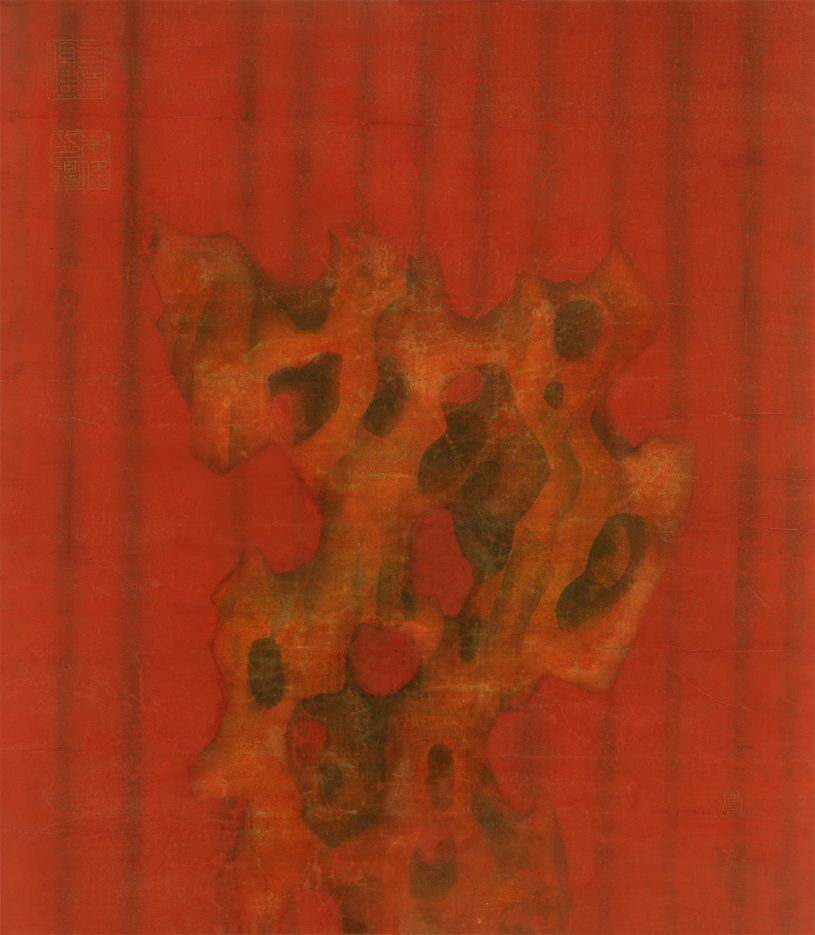
朱伟《水墨研究课徒系列》 2017 水墨设色纸本 65 × 55 厘米
朱伟很多年前完成了一批代表作:《北京故事》、《新二刻拍案惊奇》、《甜蜜的生活》、《红旗下的蛋》、《广场》、《中国日记》、《走钢丝》、《中国,中国》、《梦游手记》、《乌托邦》、《帷幕系列》、《开春图》等等。放到当下,作品的沉甸甸的分量感依旧,示范性的意义依旧。他开创了朱伟式的独特的图式——按我的老生常谈,独特的图式,加难度,加完成度,是成就一个优秀艺术家三个要素。在相当长的时间里,朱伟作品是被标签化和类型化的。由于他使用毛笔宣纸,使用本土的原材料,人们以此贴标签,以此归类,是符合常理的。我一直反对笼统地宣称当代艺术代表了“先进知识生产”这种糊涂见识,因为当代艺术中的泥沙俱下景观有目共睹。不错,当代艺术是我们时代的艺术前沿,一波又一波艺术家冲锋陷阵,使得艺术得以生生不息地精彩延续。先进性不是绝对的,是相对的,一旦被孤立,便将迅速地萎缩。换言之,先进性是变化的,依照波德莱尔的定义,事物滚滚向前,其中一半恒定,一半变化。恒定的一半是代表着不变,变化的一半则不断被变化所刷新。
一个看上去浑身散发当代气息的人,一个外表活色生香的当代人,深藏着古典执念的内心,这种矛盾是不是一种撕裂?朱伟走边缘路线,喜欢结交各式人等,曾经热衷摇滚,体育、音乐,该玩的一样不拉下。但他对人对事,对艺术对市场,却像一个老派人物,实在、规矩、讲道义。我见多了工于心计、言行不一的家伙,表面光鲜,背地里污。古人老是说,文如其人,画如其人。这是被无数实践证明的东西,让人不得不服气。我赞赏朱伟内心的古典执念。显然,古典本身已成过去,古典不可复活。那么,为何有的人深怀古典情结?原因不外乎对经典性的迷恋。就我本人而言,面对西方以往诸多经典作品,除了脱帽致敬,所有语言都属多余。回想我面对《万壑松风》和《溪山行旅》,眼眶发烫的场景始终历历在目。无须赘言,经典的魅力是永恒的,经典是艺术高度永远的标尺。可以理解一点,在朱伟这里,不存在撕裂,外在和内在寄居在同一个载体而已。朱伟对经典的敬意是从他创作的点滴中流露而出——惟其如此,所谓的古典执念便蕴含了某种自我较劲,一边是伟大的经典,一边是自我较劲,就如一边是镜子,一边是照镜子的人。
有些人多变,有些人不变。有些人多变是因为赶时髦,有些人不变是因为内心的诉求比时髦重要。要知道,时髦永远赶不完,影子永远不会飞在鸟前面。那些不变的人,坚守的人,心怀执念的人,有一天会被其他人一窝蜂地追赶。这个世界就是这样的奇妙,山不转水转。我期待朱伟一如既往——当然了,我期待与否,他都将一如既往。不久前,他有些沉重地对我说,我不这么埋着头一条道走下去,还能怎么走?是啊,时间不过是打个盹的工夫,朱伟却不知不觉走过了大半个圆圈——走着走着,发觉已经离开了那些为他贴标签的人群和地方,离开了众声喧哗,只剩下孤身一人。而且,他的前面没有了路。鲁迅先生说过,世上本无所谓路,走的人多了,便形成了路。这话拿到这儿来,似乎变成了一个有趣的问题:一个艺术家在茫茫大地孤身一人走一条自己的路,这条路算不算路?
2020.10.7
Link: 青桐Platan | 雅昌Artron | 李小山2004年文章“朱伟”
李小山 南京艺术学院教授,美术馆馆长,当代艺术研究所所长。 |